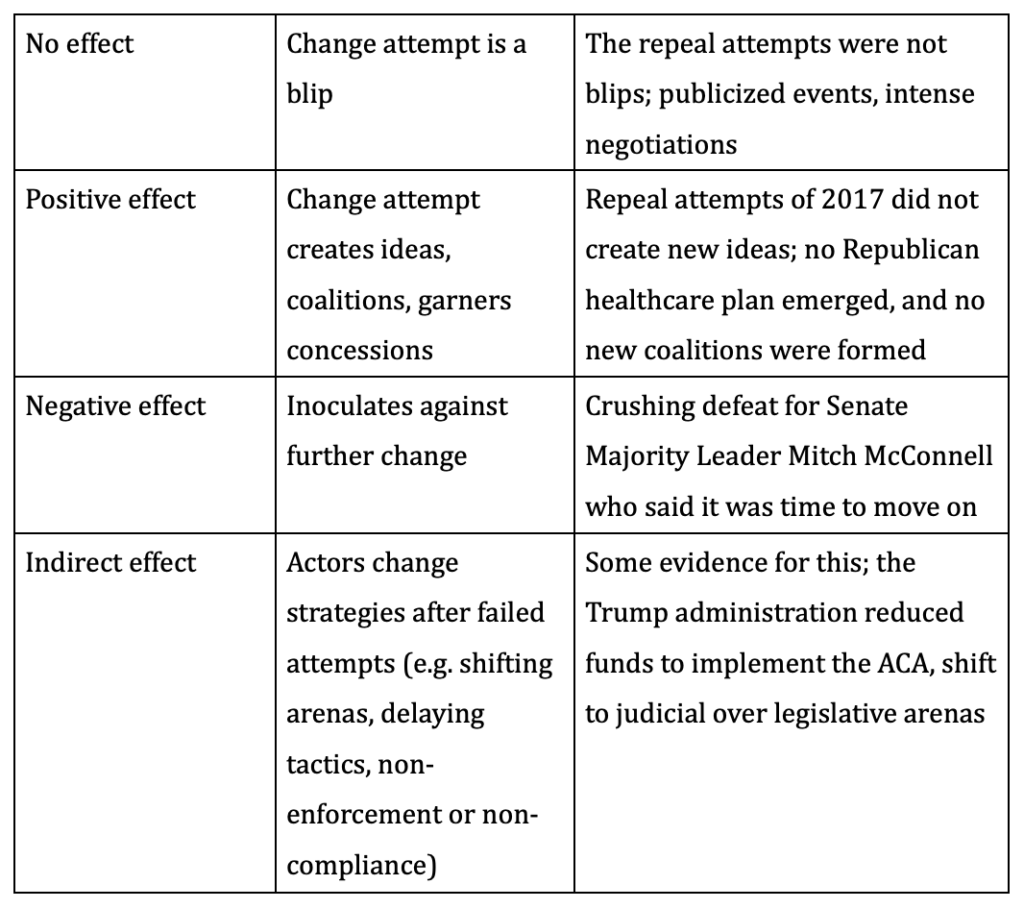The U.S. Supreme Court’s recent decision to uphold the Affordable Care Act (ACA, also known as Obamacare) is the latest in a series of failed attempts by Republicans to repeal the law. From its passage in 2010, the ACA has been responsible for reducing the uninsured population significantly through its key provisions requiring individuals to purchase health insurance, extending coverage for individuals with pre-existing conditions, and expanding Medicaid for low-income Americans¹. Republican legal challenges to the ACA started within hours of its signing. Filed by states, associations, and individuals, several cases made it to the Supreme Court, which rejected challenges to the ACA in 2012, 2015, and, most recently, June 2021. These legal defeats coincide with other failed attempts by Republicans to pass legislation in Congress that would repeal the ACA.
In our recent paper “Analyzing Failed Institutional Change Attempts”, published in Political Research Quarterly, we show that political life is full of such failed attempts to change a policy or to repeal or pass a legislation. These attempts can be big or small—some public and devastating for political careers and others minor and quotidian. Failed attempts are common in the development of political rules and regulations, often referred to as political institutions, and can have diverse effects on these institutions’ future trajectories.
In this paper, we ask how we can understand the effects of failed institutional change attempts. We show that political observers and researchers can evaluate a failed change attempt for at least four possible effects. On the one hand, failed attempts could be mere blips (no effect on the subsequent institutional trajectory) or even inoculate against future attempts of that kind (negative effects). On the other hand, failed attempts could facilitate subsequent change by introducing ideas, helping coalition building, and garnering concessions (positive effect), or convincing change agents to alter their strategy (indirect effect).
The repeated failures to repeal the ACA show the role that failed attempts can play in political life. The Supreme Court in its much-anticipated 2012 judgment upheld the constitutionality of the ACA’s requirement that individuals purchase health insurance or pay a penalty (the so-called the individual mandate). Although the Republican challenge failed, the Supreme Court ruled that Medicaid expansion could not be imposed or enforced on the states. As a result, many states did not expand Medicaid, which considerably weakened the ACA’s goals to federalize health coverage and reduce health disparities across the nation. Thus, although the legal challenges brought by Republican states to the ACA failed to repeal it wholesale, these challenges significantly weakened the reach of federal healthcare reform into state health systems and undermined the goal of the ACA to reduce health inequality across states.
While Trump declared on the campaign trail in 2015 that his administration would replace the ACA with ‘something terrific’, legislative attempts to repeal and replace it failed. In the summer of 2017, a series of increasingly watered-down bills failed to pass, ending with a dramatic thumbs-down vote from Republican Senator John McCain. In our paper, we evaluate these failed attempts for the four potential effects summarized in Table 1.
Table 1: Assessment of the political effects of the failed attempts to repeal the ACA in July 2017

In the paper, we conclude that the events in 2017 “inoculated” the ACA against further legislative repeal attempts and encouraged Republicans to change their strategy. Instead of putting forward another repeal-and/or-replace bill, Republicans concentrated on legal challenges. Building on the 2012 Supreme Court decision that upheld the ACA on the grounds that the individual mandate was a tax, Republicans added a provision to their Tax Cuts and Jobs Act in late 2017 that reduced the penalty for people refusing to get health insurance to zero.
The Republicans’ move away from legislative repeal toward undermining the ACA through different means proved crucial in this year’s Supreme Court ruling. Zeroing out the tax initially entailed by the individual mandate undermined the Republican plaintiffs’ “standing”, which the Supreme Court cited as reason for rejecting the case. In a New York Times article on the 2021 ruling, Justice Stephen G. Breyer wrote, “The state plaintiffs have failed to show that the challenged minimum essential coverage provision, without any prospect of penalty, will harm them by leading more individuals to enroll in these programs.” Moreover, he added that the individuals who had sued against the ACA “suffered no harm from a toothless provision that in effect merely urged them to obtain health insurance.”
Where does this take the ACA in the future? Legal challenges continue and the Supreme Court’s ruling based on “standing” does not stop states or other actors from attempting another salvo to take down the legislation. However, any future attempts are likely to be increasingly haunted by these failures (and small successes) of the past, underlining our paper’s main conclusion that failed institutional change attempts should be viewed as “potential key drivers of institutional development.”
¹ The overall decline is estimated to be from 18.2% (48.2 million) in 2010 to 11.1% (around 30 million) in 2020. The decrease in the uninsured population was most marked until 2016, after which there has been an increase. See https://aspe.hhs.gov/system/files/pdf/265041/trends-in-the-us-uninsured.pdf.





